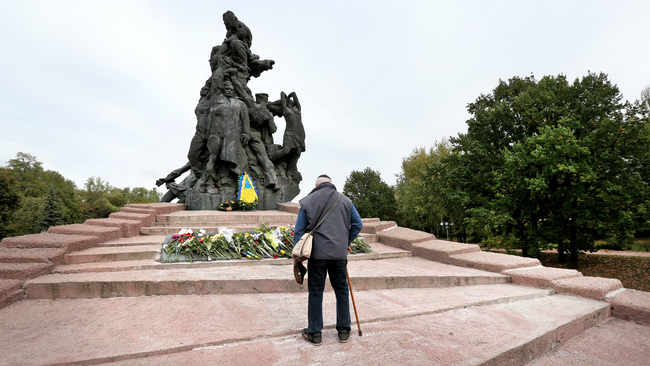In cold blood
Babyn Yar 76 years on: looking back on genocide
…At the time, it was a 2.5-km-long chain of deep ravines on Kyiv’s north-western outskirts, surrounded by a wasteland and a tract on one side and by a Jewish cemetery on the other. After World War Two, this place came to symbolize one of the most horrible crimes against humanity in history: it is here, in Babyn Yar, that the Nazi occupational authorities killed, from September 29, 1941 to October 1943, an estimated 100,000 people, including 65,000-70,000 Jews, 621 Ukrainian nationalists (among them Olena Teliha and her husband Mykhailo), thousands of Roma, a large number of Soviet resistance fighters, prisoners of war, Dnieper Flotilla sailors, Kyiv children, and mental hospital patients.
As The Day has repeatedly noted, it would not be the best idea (to put it mildly) to calculate the percentage of the innocent murder victims’ ethnicities or political persuasions. At the same time, it must never be forgotten that Jews accounted for at least 65 percent of those killed there – they were eliminated just for being Jewish. This is the way the Nazis had been villainously “solving the Jewish question” well before the related doctrine was established in early 1942. It should be a sacred place of sorrow for representatives of all the nationalities without an exception, whose sons and daughters died there, rather than a place of recreation, which it is now (especially for some extremely cynical people – this writer’s wife heard a girl with a snowboard in hand, who got off a trolleybus and walked towards Babyn Yar, say the following: “And who’s this ‘Telega’ [“cart, wagon” in Russian. – Ed.]? Why was this street named after her?” It was about Olena Teliha).
As our newspaper reiterates, it is about the presence or the absence of a governmental policy on memory (which is the right marker of a real presence or absence of the Ukrainian state itself). To memorialize the place of this heinous crime is, above all, the job of our state, not of private persons whoever they are – Russian oligarchs (I mean Mikhail Fridman, Gherman Khan, and Pavel Fuks) or foreign citizens, no matter how sympathetic they are toward Ukraine. Nor should we accept the monopoly of any nationality in venerating the memory of Babyn Yar victims. The same applies to opportunistic political shows. It is cynical. Everybody can take part if intentions and conscience are clean.
Historian Vitalii Nakhmanovych, one of most honest and profound researchers of the tragedy, has more than once focused (also on Den/The Day’s pages) on the following key points.
1 Firstly, does the Ukrainian state bear responsibility for this crime committed on our soil? It is out of the question because this state did not exist at the time. As for responsibility, it is the personal, individual, responsibility of concrete criminals, not the collective responsibility of nations, which is a category typical of totalitarian regimes.
2 The Jews were blamed for the mass-scale explosions on Khreshchatyk that began on September 24, 1941. The Nazis expected Kyivites to resort to anti-Jewish pogroms. This did not happen. Then all the Jews were ordered on pain of execution to arrive, with their belongings, at the railway station near Babyn Yar on September 29 (“to be evacuated somewhere far away,” people whispered).
3 Babyn Yar is not only the story of shooting the Jews – it is broader than the Holocaust.
4 Babyn Yar is now a virtual symbol, for very little living history has remained there. This only increases the necessity of establishing a museum complex (not an exclusively Jewish one) which would really immortalize the memory of all the innocent people, both Jews and Gentiles, who died here. The concept of this complex envisions an integrated governmental policy on memory. It is not a private affair.
***
Now about the way it was. Here are reminiscences of Olena Knysh, a Jew, the wife as Red Army man, the mother of a 14-year-old child who miraculously survived in those terrible days. “When I arrived at the assembly point, I saw an incredibly terrifying picture: an enormous crowd of people, from babies to old persons, stood under a reinforced guard of German soldiers armed with machineguns and assault rifles. Baggage was being unloaded from carts and piled up right here, people with handbags were taken to a shelter, where they were being robbed of all things, such as golden rings, earrings, brooches, watches, etc. This infernal cauldron of a thousands-strong crowd of doomed-to-death people presented an indescribable picture: cries and weeping drowned all that was going on at the place of shooting. The Hitlerites drove people to the ravine in groups of 100 to 150.”
Olena Knysh managed to escape miraculously: she lay, covered with dead bleeding bodies, for several hours and then struggled out of this together with her child. Naturally, she never forgot it as long as she lived. And we – in spite of Soviet attempts to consign this tragedy to oblivion because the victims were “bourgeois nationalists,” “rootless cosmopolitans” (the label Stalin pinned on Jews in 1948), and prisoners of war, i.e., “traitors” – do not have the slightest right to forget anything. We must not forget this also because cold-blooded murders, murders “as an occupation,” are rather widespread in the third-millennium world and genocide (in Bosnia, Chechnya, Africa, Syria, and in our Donbas) is by no means a thing of the past.
Newspaper output №:
№58, (2017)Section
Topic of the Day





